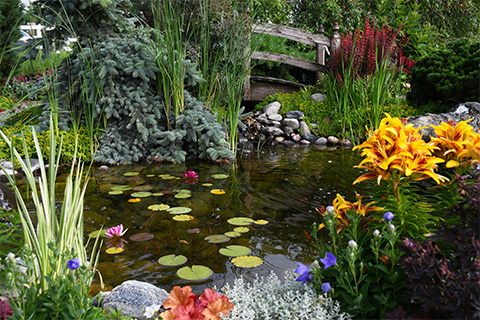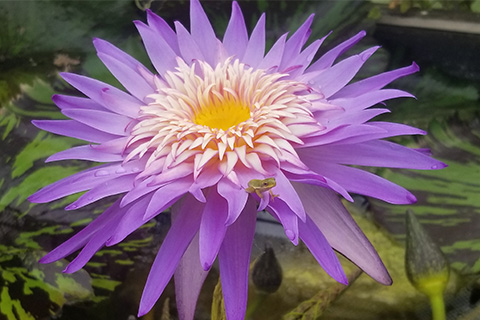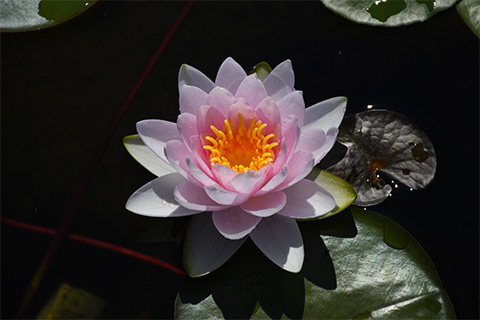5/30/2025
The Right Plants for the Pond
Matthew Olson

As consumers seek an escape from the fast-paced world, many are creating backyard retreats. What better way to relax than having a pond filled with plants and wildlife? Whether large or small, with the right plants, these areas provide aesthetic value and support local ecosystems.
An example of different options of aquatic plants for ponds from Gertens in Minnesota.
Photo credit: Lizzie Danich, Gertens
Know the Why
Ponds are a wonderful feature for any garden and water plants take them to a whole new level. Larry Nau, the owner of Bergen Water Gardens & Nursery in Churchville, New York, shares some of the key selling points for water plants.
“You look at the overall pond as an addition to your backyard landscape to help attract birds, insects and mammals. That creates value for wildlife, but also lets you focus on aesthetics with the various blooms and plant diversity,” he said, noting it also helps consumers avoid a common issue in gardening. “In the pond, you always have water available, so you’re removing the uncertainty of under or overwatering the plants.”
Types of Aquatic Plants
Ultimately, the pond’s size will have the biggest effect on the number and type of plants to use. But, first, let’s explore the different categories of water plants typically offered to consumers. I spoke to Brad Payne, assistant manager of trees at Gertens, an independent retailer near the Twin Cities. He mentions three main categories of water plants: “We have the lilies and lotus, which give you the most pop of color. These are often the main interest for your pond.”
Many varieties of water lilies are hardy for northern climates, and they come in a wide range of sizes and colors.
Next up, we have floating plants. As the name suggests, they float on the surface and move around the pond. They also reproduce quickly, making it easy to fill space. For Gertens, this category includes their most popular aquatic species: water lettuce and water hyacinth.
“These annuals do great in warm water,” Brad said. “Water hyacinths have stunning purple flowers, while the leaves of water lettuce can tolerate more shady areas.”
In many cases, floating plants are annuals in northern gardens, but there are hardy options, too. And some species, like the water hyacinth, are considered invasive in warmer climates—a good reminder to know of your local regulations before selling any type of plant. Besides looking good, floating plants reduce algae by shading the pond and absorbing large amounts of nutrients.

Lastly, we have the marginals, which include the most diverse plant selection. From tropicals to hardy natives, these plants add structure and color along the pond edges. Additionally, they serve as a natural water filter and offer protection for wildlife. And speaking of wildlife, Gertens has seen an uptick in people using ponds for their indoor pets.
Nymphaea Foxfire water lily.
Photo credit: Michael Swize, Nelson Water Gardens
“In the past few years, we’ve seen more people bringing their indoor reptiles and fish outside to the pond during the growing season,” Brad said. “The direct sun is better for them and enriches the animals’ lives.”
In northern climates, consumers also have to consider how winter will impact the plants.
“For hardy plants, the biggest factor is the pond depth,” Brad noted. “In Minnesota, the ice can get 18-in. thick in some years. Having the plants at least 2 to 3 ft. down on a lower shelf is the best place to overwinter them. Come spring, you’d want to return them to the higher shelf.”
Regional Differences
Rolf Nelson is the owner of Nelson Water Gardens and Nursery in Katy, Texas. For almost 30 years, he’s been helping consumers choose the right plants for southern water gardens.
“In the deep south, it’s a no-brainer to go with tropical lily,” Rolf said. “You’ll get plenty of flowers during the growing season. And when you’re this far south [Houston area], they’ll survive the winter. Once in a while, you get outlier cold snaps, but the plants will go into dormancy and come back in spring.”

Whether consumers are growing hardy or tropical water lilies, each type will have colors that don’t exist in the other group. An example is true red flowers, which only exist among the hardy lilies.
Nymphaea Madame Wilfron Gonnere hardy water lily.
Photo credit: Lizzie Danich, Gertens
One plant category that’s often overlooked is the submerged grasses.
“These are the workhorses of the pond,” Rolf said. “They keep your pond balanced and control the algae by out-competing algae for free nutrients in the water. Additionally, they provide cover for your fish.”
Garden centers can use ponds to encourage adding natives to the plant palette. However, the right native depends on the pond size.
“Many of our native aquatics are the most aggressive plants out there, so they’re often not the best choice for a small water garden,” he said, but not all natives share the same level of aggression. “Pickerel Rush is a good player and we like the Louisiana Irises to kick off the season. The iris is a good spring bloomer with an incredible number of varieties and colors. Perhaps our most popular aquatic groundcover is Lemon Bacopa, which has lemon-scented leaves and small blue flowers.”
In New York, Bergen specializes in lotus plants, offering nearly 250 varieties to consumers. A common misconception is that lotus are annuals, but that’s often not the case.
“As long as they don’t freeze solid, and they have some water above them, they come back every year,” Larry said. “We have a collection of over 120 ponds that are only 24-in. deep and 95% of the lotus come back every year. Lotus will typically bloom in our area from late July through September.”
Consumer Education
It’s one thing to discuss water plants with consumers, but many want to see the real thing before buying. All three of these nurseries use display gardens to highlight the plants and the materials needed to grow them.
At Nelson’s, the staff hosts classes to provide a hands-on experience for consumers.
“With so many regional differences, customers need to have local information that applies to them,” Rolf said. Additionally, Nelson creates online guides that help consumers prepare their ponds for extreme weather, like hurricanes and freezing temperatures.
Gertens has an online water plant guide that shares descriptions and images of each plant category, along with specifics about different species.
In New York, Bergen has a Lotus Fest each year in July to showcase the unique varieties and share the rich history of the plant. Additionally, their website shares tips for planting and using lotus in decorative pots.
Like their counterparts on land, water plants offer many benefits for consumers and the environment around them. GP
Matthew Olson is a professional horticulturist and garden writer. He regularly writes articles about gardening for consumers and industry professionals. You can reach him at matt@mattolsonhorticulture.com.
The Right Number
Once consumers understand the role of each plant, they can look at how many plants to add to the pond. For example, a small pond (100 sq. ft.) may include one to two lilies, five to eight marginal plants and three to six floating plants. A larger pond (300 sq. ft.) can handle up to five large lilies, 15 marginals and 12 floaters. Typically, it’s good to have around 40% to 60% of the pond surface covered with plants.